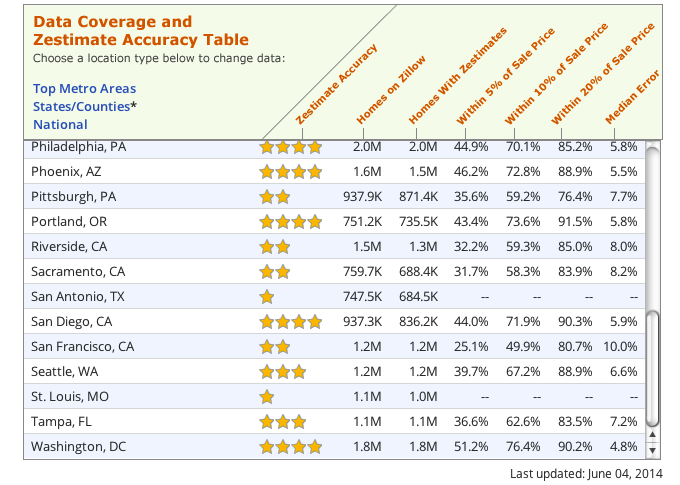Are Zillow’s “Zestimates” Full Of Zhit? Depends Who You Ask

Some of Zillow’s own stats on the accuracy of its Zestimates. As you can see, the margin for error ranges from as low as 4.8% in D.C. to a whopping 10% in San Francisco.
In dueling stories in today’s Washington Post, the chief information officer of a D.C.-area real estate company and Zillow’s chief economist provide very differing opinions of Zestimates, which the realtor describes as “wildly inaccurate and inconsistent.”
“Market pressures change from week to week and from neighborhood to neighborhood,” he writes. “No algorithm, however sophisticated, can quantify the value of a kitchen that was remodeled just before a home was put on the market or a yard that is poorly maintained. It simply isn’t possible for any AVM [automated valuation model] to predict the value of a home with a level of accuracy sufficient to make a housing decision.”
The popularity of Zillow, mixed with buyers’ and sellers’ desire to have some sort of definitive number to slap on a property, results in too many people looking at Zestimates as gospel instead of the mere starting point that the site intends them to be.
“[N]ot a week goes by that we don’t encounter a consumer who is fixated on a particular value for a home because that’s what Zillow says it is,” explains the realtor. “Kudos to Zillow for making this kind of impression on the public — brilliant marketing. But our research shows that, on average, those ‘Zestimates’ are within 5 percent of the actual value of a home just half of the time.”
Which, as he points out, is similar to Zillow’s own stats for the D.C. area.
The question is whether that it’s okay to be within 5% of the actual value half of the time.
Not surprisingly, the realtor says no.
“As real estate agents, if we got within 5 percent of the value of a home that infrequently we’d be out of business,” he claims. “So if consumers want to base their valuation of a home purchase or sale on what they find on the Internet, we suggest they take out a coin and flip it.”
He points out that this means that the other half of the time, the Zestimates can be 10-20% or worse off from the actual sale price. In fact, Zillow’s data shows that around 1-in-10 D.C.-area homes sells for more than 20% off (higher or lower) its Zestimate.
In a market like D.C., Northern Virginia, and Maryland, there are some pretty pricey houses, so being off by even 5% can easily mean $15,000 to $50,000 of a difference. And the problem is much worse in other markets. For example, in San Francisco — one of the most expensive areas to buy in the country — only 25% of Zestimates fall within 5% of the actual sale price.
Zillow defends Zestimates, saying they have not only improved in recent years (the realtor agrees with that) but that they now are similar to what you’d get from a human real estate agent.
Beyond that, Zillow says that Zestimates are just meant to provide a helpful snapshot and that the number calculated by its computers should not be taken as the definitive estimate.
“On its own, the Zestimate allows users to quickly answer a host of important questions,” writes the site’s chief economist. “Am I likely underwater on my mortgage? How much value has a homeowner gained or lost since buying? What is the value of this home, relative to a similar home in a different part of town?”
I took a look at the Zestimates for my neighborhood in Philadelphia and found some very confusing Zestimates. My neighbor to the right has a house Zestimated at 50% more than mine while the house to my left is Zestimated 30% less. Thing is, these are virtually identical properties; all the same size, number of rooms, built at the same time, etc.
If I believe the one neighbor’s Zestimate, I’d be an idiot not to sell and run off with a huge profit. But if I turn the other way, I’m underwater on my mortgage and won’t be able to sell for years.
“The Zestimate is also designed to be used in conjunction with many other pieces of information because we know there are decisions when sometimes you need more than a Zestimate,” writes the site’s economist. “In these cases, we always recommend supplementing the Zestimate with professional advice. Great agents provide services far beyond just pricing a home: assistance in negotiation, help with marketing and priceless peace of mind. A computer will never replace that.”
What all of this means is that Zestimates are just a number and they’re only based on publicly available data. It doesn’t know that the counters in a home are ugly as sin, or that the previous owner had a cat with a bladder-control problem, or that the seller has lovingly cared for every inch of the property for three decades.
No matter how much you wave it around and point to it with urgency, a Zestimate isn’t going to convince a stubborn seller to come down on a price or a bargain-hunting buyer to improve his offer.
Want more consumer news? Visit our parent organization, Consumer Reports, for the latest on scams, recalls, and other consumer issues.

